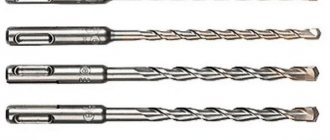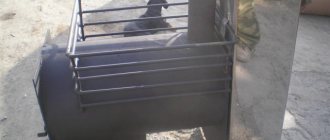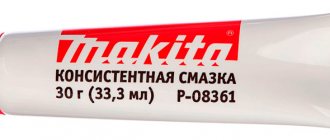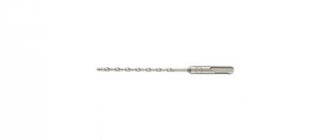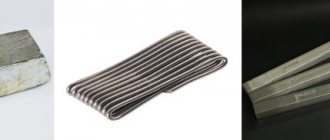A hammer drill is an equipment used to make holes in the structure of dense materials (stone, concrete, brick, reinforced concrete). Applicability and quality depend on the type of product, material and design features, which we will discuss further.
Choosing a concrete drill for a rotary hammer Source stroevod.ru
The difference between a drill and a drill
Many home craftsmen have become acquainted with the hammer drill quite a long time ago. As a rule, it is used in cases where drilling and chiselling is necessary to solve the problem at hand. A modern hammer drill differs from a conventional drill not only in functionality, but also in design. It is equipped with a cartridge lock designed to secure replaceable attachments. The latter refers to a variety of tips in the form of blades, drills and chisels.
When choosing concrete drills for a rotary hammer, you must also pay attention to their dimensions. It may seem to some that the drill used in hammer drills is no different from the well-known Pobedit drill, which is used for drilling with an impact drill. However, in reality this is not the case. The drill has a smooth shank, but the drill has a complex shape.
How to choose the right drill
An important point is the correct choice of element for drilling. It is necessary to focus on the degree of surface strength. The steepness of the spiral plays an important role in this regard. The higher the indicators, the deeper the hole is made in the minimum amount of time spent. The secret is this. Thanks to the greater steepness, waste material is removed more efficiently, which speeds up the drilling process.
Advice from professionals will help you choose the right tool:
- A hole with a small diametrical cross-section is made using a mini-drill with a flat spiral. These are the ones that have a high degree of strength and service life.
- The manufacturer's brand should be taken into account. Unknown models are often of poor quality and do not always correspond to the dimensions of the hammer drill base.
Criterias of choice
The spiral-shaped grooves have an optimal sharpness so that they can make a hole in the material. But these grooves perform a double task - they are also necessary for the timely removal of dust and crumbs while working with a hammer drill. In stores you can also find models of hammer drills that have triple spirals. However, when choosing the size of concrete drills, you should first of all proceed from your goals.
Another feature that distinguishes a Pobedit drill from a drill is its tip, which provides the ability to drill and chisel hard materials. If you have a three-mode hammer drill at your disposal, you can use it as a regular drill. In other words, regular drills are also suitable for this tool. But to use them, you will have to install an adapter, which many hammer drill models often come with.
Wood drill for hammer drill
Drills are mainly used to make holes in wood, but a drill is more productive. For example, a drill such as Blue Groove 6x IRWIN from the American company IRWIN (IRWIN) performs this operation 6 times faster. A wood drill for a hammer drill also has the following advantages:
- Chips are removed quickly, because there is a 3-sided cutting spiral;
- the applied effort is reduced due to the presence of a self-tapping screw tip;
- The wood is not destroyed when drilling holes thanks to the cutter for clean drilling.
Finally, watch the video:
Recommendations
If there are no other options, you can go the other way and install the drill in a drill, provided that it supports impact mode. But you should not count on high efficiency and productivity of such a symbiosis. Also keep in mind that after work you may have difficulty removing the drill from the chuck. And attempts to pull it out on your own do not always end well. So be prepared to have to repair your old drill.
Even though a rotary hammer can successfully perform complex tasks, manufacturers have not ignored this point and have offered improved solutions. As a result, today on the market you can find several types of quick-release chucks designed for attaching a shank attachment of a certain shape. Moreover, each similar type is allowed to be used only under a certain load.
The most commonly used types of nozzles are:
- plus;
- max.
What they have in common is that they are manufactured according to the SDS standard, which allows you to attach any such attachment with one movement of the hand. But there are very few such options in stores in their pure form. The intermediate version SDS-top is more common.
To choose the right type of attachment for a hammer drill, you need to refer to the instructions. From it you can find out which of them the tool supports working with. And only after receiving the answer to this question can you begin to select a hammer drill. After all, if you have at your disposal a tool that supports working with a rare variety of consumables, then you will have to be a buyer of a specialized store for a long time, and this can be quite problematic for some owners.
Please note that each type of hammer drill has its own set of drills. For greater convenience, all models are usually classified into three main groups: heavy, medium and light. The first are jackhammers that can only be used with suitable attachments.
We select, design and modernize a hand drill. Personal experience
A hand drill is an indispensable thing on a personal plot. Drill holes to install fence posts or bored piles under the foundation, make holes in the garden soil for planting plants. There is always a use for this hand tool. Users of our portal know how to make this tool yourself, and whether it is possible to somehow improve factory-made devices.
Before you buy or make your own hand drill, you need to ask yourself the following questions:
- For what purposes and work do you need it;
- What type of soil will be drilled at the site.
Sand, rocky soil, abandoned garden soil, hard clay, loam, soil with a lot of roots. Drilling a hole for installing fence posts and posts of small diameter, drilling out “heavy” soil for powerful bored piles for the foundation of a house. All these factors have a significant impact on the design of a hand drill.
Sukhanov Mikhail FORUMHOUSE user
In my opinion, the best hand drill is the one that is “tailored” for work in a specific area, taking into account the characteristics of the soil and its layers. Those. the earth drill must be made for specific tasks: installation of pillars, piles, etc.
A user of our portal offers the following mechanical design for a homemade drill. How it was made can be clearly seen in this photo.
Two knives are used to preliminary loosen the soil, which simplifies the cutting of the main blades, set at an angle, into the ground. Moreover, the main blades can be made replaceable by attaching them to bolts and nuts. Thanks to this, it is possible to drill holes of different diameters using one rod.
Although the purchased and homemade drills are similar in appearance in many ways, it is the homemade hand drills that show the best results. They are stronger and more convenient to work with, because... they are made to suit you.
Sukhanov Mikhail
My neighbor and I once conducted the following experiment: we decided to compare the performance of my homemade drill (blade diameter 25 cm) and its purchased one (blade diameter 14 cm).
The soil on the forum member’s site is like this:
- 0.7-0.8 m – “fertility”;
- 0.2-0.4 m – coarse limestone stone;
- then a layer of marl (yellow, with fine limestone chips).
During the competition, the drillers almost simultaneously went 0.8 m deep. Then the purchased tool stumbled on the marl, while, working as a homemade garden drill, Mikhail continued to drill as if nothing had happened. The neighbor had to loosen the marl with a crowbar and only then drill further.
The result of the experiment: it took Mikhail a little over 5 minutes to drill a hole under a pillar 1 meter deep, and he was not at all tired. The neighbor fell hopelessly behind in the last 0.2 m.
T.N. a universal drill, no matter how suitable for working on different soils, may turn out to be ineffective.
That is why homemade hand drill designs are so popular among users of our portal. To make one, all you need is scrap materials and basic welding skills.
The tool is made like this: take a round or square pipe, its length is selected depending on the expected depth of the hole. In the case of mechanical drilling of deep wells, the pipe can be extended by extending it with an additional rod. The diameter of the blades is selected depending on the expected diameter of the pit and the planned work.
Large-diameter saw blades from circular saws have worked well as blades. Such a disk is sawn into two parts with a grinder. The halves are welded to the pipe, and the blades must be spread to a certain angle (approximately 25-30°). This way they penetrate better into the ground. A lance or a large-diameter “killed” drill is welded to the end of the pipe. The tip is needed to center the drill at the beginning of drilling. Due to the saw teeth on the blades, such a tool cuts roots well when rotating.
The main thing when working with a hand drill is to stop in time and lift it out of the pit in order to dump the rock.
Boston FORUMHOUSE user, Moscow.
I made two earth drills for the beginning of the summer season. The first is with a diameter of 210 mm, the second is 160 mm. Circular discs were used on the blades. The rest was made from what was literally lying under our feet. I also made a collapsible extension rod. I spent 200 rubles on everything, as they say, cheap and cheerful.
If you don’t have a welding machine at hand, then such a tool can only be assembled using bolts and nuts. Also, as a drill for light soil and for drilling small-diameter holes, you can use a used ice auger (since buying a new one is an economically unjustified idea). For ease of operation of the ice device, you need to cut off the handle-turn and attach a standard T-shaped collar.
In addition to the tools described above, an interesting approach to making a homemade drill for drilling wells in the ground is from a forum member with the nickname VyacheslavK.
A conventional earth drill was used to drill to a depth of 2.5 m. The forum member cut the blades with a grinder from a piece of sheet metal 3 mm thick, onto which a paper template was previously glued.
Then a hole with a diameter of 20 mm was drilled in the resulting workpiece.
A cut was made along the radius of the circle.
Next, Vyacheslav K welded a pin into the blade, which he inserted into the pipe. The pipe is also welded to the blade.
The pin has been sharpened.
The result is a drilling device like this.
During the work, the following shortcomings were identified and eliminated:
- The blades are brought together during drilling, which significantly reduces drilling efficiency. To prevent the blades from collapsing, bracing partitions were welded between them and to the pipe.
- When drilling holes for installing a fence, the tool, if it bumped into stones or roots, was pulled to the side. To eliminate this drawback, an arcuate side of 30x10 cm was welded one blade at a time, starting from the bend of the circle.
- Low efficiency when passing through oily clay. For working with clay, the so-called was made. frame drill designed by a user of our site with the nickname KND.
This device is best suited for working with lamellar clays. It has a minimum coefficient of friction against the rock. It is easy to remove from the hole (there is no “piston effect” like an auger drill). After lifting the drill, the clay is simply shaken out of the frame.
Although such a tool is most often used when drilling homemade water wells, its design turned out to be so successful that it is worth focusing on it.
VyacheslavK did this:
From a strip of metal 5 cm wide, he cut two identical strips and made angular bevels, moving 2 cm from the end of the strip. For the strips, you can use old car springs.
Cut and sharpened knives.
I welded the knives to the drill, pointing the sharpened sides in opposite directions.
I spread the knives apart using a corner so that the distance between the ends was 25 cm.
Using a gas wrench, VyacheslavK turned the knives at an angle.
I assembled and welded the entire structure.
It is worth noting that the drill quickly broke off. Therefore, VyacheslavK sharpened the fragment, as shown in the next photo.
When making a frame drill, it should be taken into account that it is not suitable for working in loose, loose soil, because it doesn't stay in the frame.
Also interesting are the designs intended for making a widening - “heel” - during the construction of the TISE foundation.
Subarist FORUMHOUSE user
I modified the purchased drill and installed a second folding shovel on it. To make it easier to work, I made a T-handle 1 m long. Thus, I increased the force on the lever. The length of the rod is 3 meters. Now you can drill holes 2 meters deep while standing upright, rather than on all fours. I cut off the teeth from the land receiver because they are of little use.
The “improvement” did not end there. To increase the efficiency of the earth drill when drilling out the widening, Subarist bent the blades - straight ones did not cut the soil well. The forum member’s future plans include installing blades made of alloy steel, because... ordinary ones quickly become dull on stones.
Advice: when making a foundation of the TISE type, it is best to drill the base hole with a conventional drill or a special mechanical tool with a “drain pan” and two folding blades. This will save time and effort.
ValentM FORUMHOUSE user
I made an earth drill using an ordinary saucepan as a soil accumulator. With this tool I made widening at a depth of 2.5 m.
There are stoppers at the bottom of the pan that rest against the ground. When drilling the expansion, the pan stands still , this increases work efficiency, because no effort is wasted on turning the earth receiver itself. When the handle rotates along the threaded shaft, the blades open and cut the soil. After the pan is filled, the handle of the drill rotates in the opposite direction, the blades fold, and the drill rises to the surface. In 4-5 lifts, the hole with widening is completely drilled out.
It is worth considering that making such a tool is more difficult than a regular one - you will need a welding machine and a lathe.
The design turned out to be successful and in demand. Using this principle, forum members make their devices with two blades, which most often work in tandem with motor drills.
FORUMHOUSE explains in detail which hand drill to choose. The topics include advice on the global modernization of the TISE drill, and recommendations on how to independently manufacture an electric hole drill. It will also be useful to study the topic that tells how to drill an Abyssinian well. From the video you will learn why you need to examine the soil on the site.
Expert opinion
If you have a middle or light class hammer drill, then to work you will have to purchase a plus type shank for it. But max shanks can only be used for heavy class attachments.
Today, manufacturers are trying to satisfy the needs of every customer. To do this, they are expanding the range, adding new adapters that allow drills of one class to be inserted into the chuck of another.
Although this is very convenient, experts do not recommend using such solutions. After all, each hammer drill was originally created to work with a nozzle of a certain size and weight. If nothing happens to a heavy hammer drill when using such consumables, then the medium and light ones will not work for long and will soon require repairs, the cost of which will be quite high.
Working part of the drill
The working part of the drill that directly performs the drilling process is made of a metal alloy, and labor productivity and the safety of human use of the hammer depend on its condition. The working part can have different shapes and is classified according to purpose as follows:
- an auger drill is an excellent option for making deep holes of various diameters. Its spiral design and high torque allow it to effectively remove dust and sludge during operation, thereby reducing the load on the tool and reducing the time it takes to complete one hole.
- a drill with a small angle of inclination of the working grooves - for working with extremely little effort (for example, in Makita rotary hammers). Its purpose is the process of drilling a significant number of shallow holes.
- drill with a large angle of inclination of the working grooves , providing high drilling speed and productivity of the process itself. The load created on the hammer drill is higher than when using auger drills. Optimal for drilling single holes of great depth.
Drills with one or more spiral grooves, as well as grooves of specially designed shapes, ensure the stability of the drill, its balanced central placement during drilling, reducing vibration, and, consequently, the load on the hammer drill and the productivity of the work performed.
Popular drill sizes
Most often, to solve everyday problems, buyers purchase drills made in the form of ordinary drills. They have a spiral cutting part, which independently removes destroyed material elements from the internal space of the hole. A distinctive feature of drills for concrete hammer drills is a very durable cutting edge, for the manufacture of which carbide materials are used. This part has a rounded shape, due to which the nozzle can withstand quite significant shock loads.
If you need an attachment for professional work, then look for auger drills for a rotary hammer with a centering spike and self-sharpening working edges. When planning to buy a drill bit for a concrete hammer drill, remember that it cannot be sharpened, repaired or leveled. During work, it is necessary to periodically take breaks, during which the hammer drill should be cooled and washed. Despite the high strength claimed by the manufacturer, we must not forget that the drill is just a consumable material, so it must be handled very carefully.
Most often, owners buy drills with a size of 6 mm for a hammer drill. They are offered in small packages containing no more than 10 attachments. Before purchasing this consumable, carefully consider the spiral. It is desirable that it be as twisted as possible. Then you will not have problems removing waste material, which means you will be able to quickly and efficiently create holes in the structure.
The strongest are the drills whose spirals are twisted to the least degree. The most common option in stores is 6 mm concrete drill bits . Nozzles that are made according to the SDS-plus standard most often have a shank diameter of more than 10 mm. As for the diameter of the consumable itself, it can vary from 4 to 26 mm.
The length of the nozzle may also vary, which can range from 100 mm to 100 cm. When choosing a consumable, it is necessary to take into account not only the length of the drill, but also the shank. If you need drills for working on concrete, do not neglect the recommendations of a specialist.
A hammer drill belonging to the heavy class can be equipped with attachments with a shank diameter of 18 mm. The value of this parameter for a drill can vary within 20−80 mm. In such a nozzle, the spiral is designed in such a way that it contributes not only to the effective removal of slag, but also to the cooling of the surface with which it comes into contact during operation.
Such consumables are often used as break-through materials. They make it easy to destroy the wall in which the doorway is created. You can also find drills made in the form of crowns in stores. They are designed to create holes for switches and sockets. If you are interested in purchasing a drill for a concrete hammer drill with particularly large diameters (up to 65 mm), then stores can offer you entire systems designed to solve particularly complex problems. For example, if you need to create holes in a reinforced wall of considerable thickness.
Review of the best garden drills
Now let's move on to specific examples of garden drills that have good characteristics and have won the trust of customers.
| Nomination | place | Name of product | price |
| Review of the best garden drills | 1 | Fiskars QuikDrill Fiskars 1000640 (134730) | 4 529 ₽ |
| 2 | BISON EXPERT garden manual, diameter 250mm | 5 530 ₽ | |
| 3 | TORNADO PROS | 1 050 ₽ | |
| 4 | Sibrtech screw, diameter 25 cm | 724 ₽ | |
| 5 | Bison 39491-200 | 1 710 ₽ | |
| 6 | FIT 110 x 11 cm | 796 ₽ |
Main types of drills
The dimensions of concrete drills for a rotary hammer are a very important parameter that you should definitely pay attention to when choosing. At the same time, it wouldn’t hurt for every owner to know about the existing varieties of these consumables.
- If, for example, you need to install electrical wiring in a wall, then it is best to purchase a drill bit for this work. It will allow you to make holes of any diameter in concrete structures. This way, you can easily install switches, junction boxes and sockets.
- Another fairly popular consumable is a flat chisel, designed for more accurate drilling of concrete structures.
- Some operations cannot be performed without a peak-shaped chisel. It allows you to destroy concrete most effectively.
- You can also find in stores a type of consumable for a concrete hammer drill, such as a channel drill, which is ideal for laying electrical wires.
Categories and types of drills
The diverse selection of working tools is explained by the fact that the tool is used when working with materials of different strengths - each requires its own specific consumables. There are different shanks, nozzle sizes, tip shapes and manufacturers that expand the price range.
Let's look at the differences in the material being processed.
On concrete
Diamond-coated drills are suitable for drilling in concrete - they are strongly reinforced: they have a high safety margin. Such parts are widely used in professional environments due to their reliability, durability and performance.
Set of drills for drilling with a rotary hammer
By brick, stone
Household drilling tools for stone and masonry are often used in interior renovations. Preference is given to nozzles with graphite tips and an SDS-Plus shank.
On wood
Unlike concrete, stone and brick, wood is a soft material. Accessories for rotary hammers are not used when working with it; drills are suitable instead. This tool must be used in drilling mode. The diameter and type of shank are selected taking into account the required hole size and the selected characteristics of your power tool.
Manufacturers of consumables for rotary hammers
After studying the above information, it will probably be easier for you to choose the appropriate size drill for effectively performing concrete operations. But this is not always enough to achieve high-quality results. Much depends on the manufacturer of the consumables for the hammer drill. Today, drills are produced by 14 enterprises. All these models can be divided into two categories:
- drills from official manufacturers;
- non-original consumables.
In the case of the latter, you cannot be sure of the quality of the products, since the manufacturer does not provide a confirming certificate. Many problems arise with original drills. An example of this could be the situation with the DreBo Werkzengfabrik plant. In addition to the fact that it produces drills under its own brand , this manufacturer also supplies consumables for other fairly well-known companies - Wurth, Milwaukee, and Hitachi. To avoid making mistakes, you need to look not only at the brand, but also at additional parameters, as well as the shape. After all, such products will not differ in quality.
Not every tool can cope with the task of drilling holes in concrete structures. Many owners have long been convinced of how ineffective a conventional drill can be. Therefore, for such a case, they have the best solution to date - a hammer drill.
But even a correctly selected hammer drill does not guarantee that you will be able to quickly create a hole in concrete of the required size. Much depends on the drill used. But choosing it is not so easy, since today there are countless options available in stores. In order to choose a drill bit for a concrete hammer drill of suitable sizes, it is necessary to take into account both the type of tool and the nature of the task facing the owner. If there is a discrepancy, there is no guarantee that the work will be completed accordingly .
And it is advisable to approach this issue not alone, but together with an experienced specialist. After all, not every owner knows exactly which drill is best to drill into the material. Therefore, if you do not want to experience the bitterness of disappointment, try to study this issue as carefully as possible.

